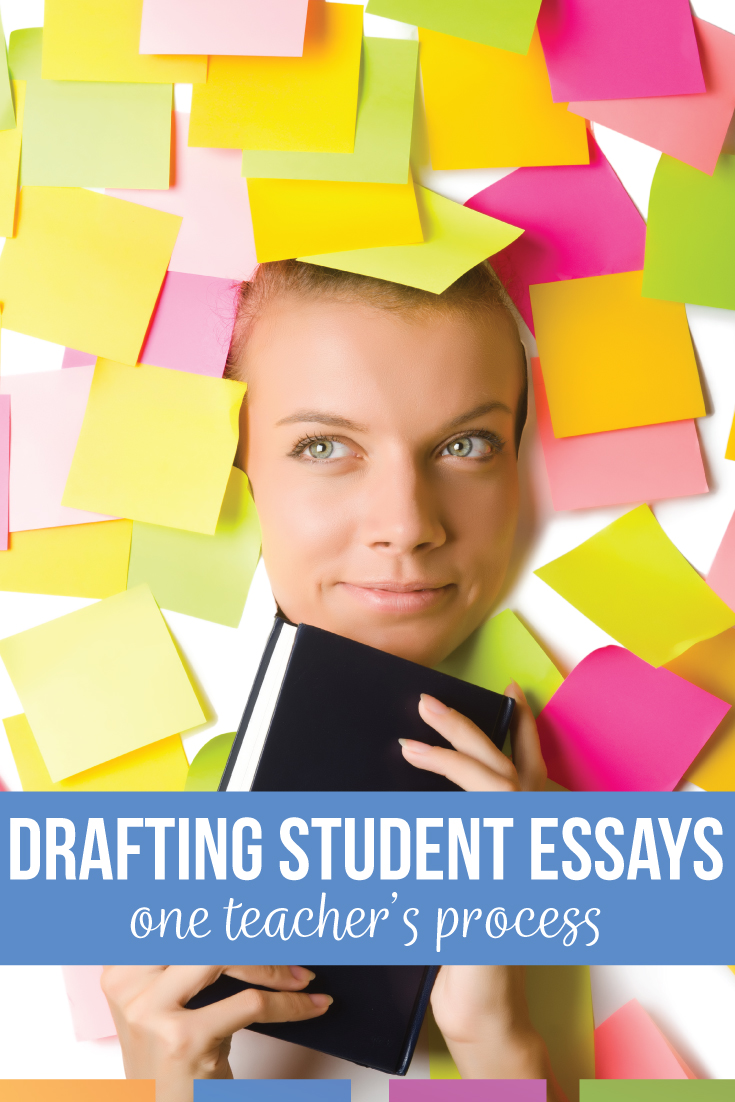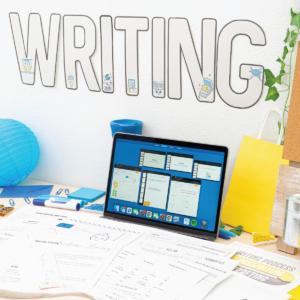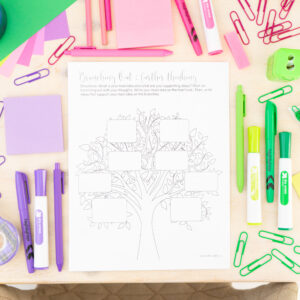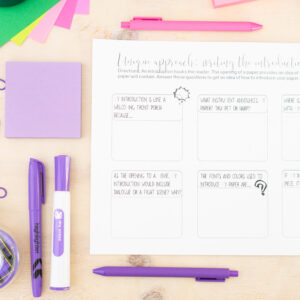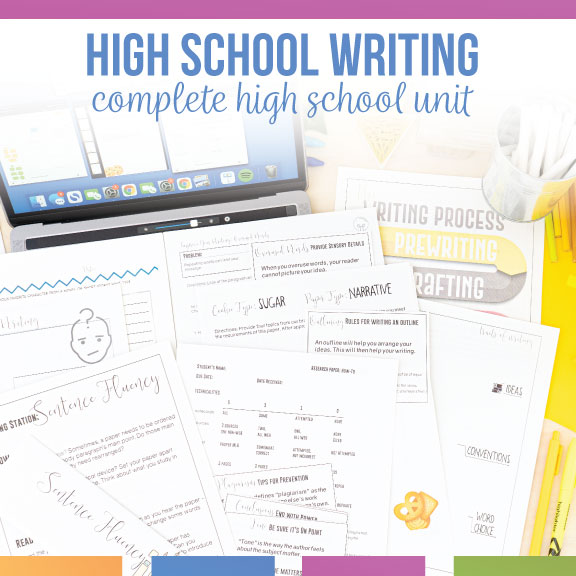Drafting an essay with high school students takes patience, time, and modeling.
Drafting is the second stage in the writing process, following prewriting or brainstorming. The entire writing process (prewriting, drafting, revising, editing, and publishing) is familiar to most high school students. I don’t hang a poster that outlines the system because my students use that terminology correctly.
Now, in my entire series about the writing process, I’ve stressed that I never stop students from moving around the process. When I write, my process is messy, physically and mentally. Sometimes I hold a huge brainstorming session before publication because I feel that I’ve developed more ideas or better ways to express my ideas.
I sometimes share why writing is recursive. Sometimes students (like all writers) become frustrated with their writing. When I stress that writing is never a “one and done” sitting, they’re relieved. They’re not bad writers; they are like professional writers! They simply don’t know what to expect as they write their papers.
How can helping students draft an essay or a paragraph work?
So after brainstorming, I spend some time prepping students to draft their papers. Don’t skip the “prep” of drafting. Hurrying through results in frustration, not a shorter process. Helping students draft an essay takes time.
The format
Overwhelmingly, I move students (especially upperclassmen) away from the standard 5-paragraph essay. Some students are resistant to change. Dependent on many variables, I do allow it. With reluctant writers, I address their concerns and when they are not ready to move from its safety, the 5-paragraph essay it is.
Mostly I encourage students to develop their papers based on what their topics call for. Argumentative papers easily lend themselves to more elaborate designs because the counter-claim can have many facets. Student writing develops different ways, and English teachers must stress that good writing comes in many formats.
Mentor texts are a great way to help students see that moving away from the 5-paragraph essay might make their process easier than sticking with it.
Topic sentences, thesis statements
From our prewriting, we decide the body paragraphs before drafting an essay. At this point in the writing process, students and I write out the topic sentences. Because we brainstorm or pre-write for a lengthy period of time, the topic sentences are evident.
Then I ask students to write their thesis statement. Again, from looking at the prewriting and topic sentences, the thesis is obvious. Celebrate with young writers—they should have clarity on their piece of writing.
A thesis statement is massively important, and it can stress students. Like so much, the thesis is a work-in-progress. If a student writes a list for the thesis, I consider it the rough draft of the thesis. We’ll revisit it.
But! Some students crave that thesis: Writing a paper for them requires the thesis before the topic sentences. We write the thesis by returning to the prewriting. Then, we work on the topic sentences. I typically present those two methods to students: thesis or topic sentences first? I’ve provided student choice, but I’ve narrowed down their options so they’re not overwhelmed.
Primarily, I treat the topic sentences and thesis statements as the skeleton of the draft. Once the topic sentences and thesis statement are written, we work on the introduction.
Introductions
I don’t stress the introduction and conclusion at the start of the drafting process because I’ve witnessed most students add to them as the draft continues. When students think about their introduction, I prompt them with several questions to get them thinking about drafting the introduction: What is the. . .
- intro song for your paper?
- the biggest message you want to convey?
- the most interesting idea to introduce to your audience?
Some papers’ introductions lead to the conclusion easily. Young writers write the introduction and conclusion along with the topic sentences and thesis statements, and then fill in the rest of the paper. The conclusion could answer a question from the introduction (for example), and the writing of the conclusion comes before the rest of the paper.
The guts
After we’ve talked through the introductions, thesis statements, and topic sentences, students and I dive into the guts of the paper—the body of your essay. We fill out paragraphs and add appropriate research. Together, we’ll search for the right words and phrases.
Again, I don’t heavily regulate this part of the drafting process. A first draft is imperfect, and I don’t want to disrupt a writing groove. However, if I see a student wandering the wrong way, I’ll speak up:
- No research. If ideas are not supported by credible research, the student should maybe return to the prewriting stage. If not research exists, the student should check that their ideas are not erroneous.
- Too much research. If entire body paragraphs are paraphrases of other people’s ideas, the student should work on their own idea.
- Deviation from the topic sentence. I’m fine with changing the course of a paper, but if a student fails to realize they’re off course (or are writing multiple paragraphs about the same topic), we have a focus problem.
The point of drafting is to get ideas on paper. Unless I see a student winding down a path that will cause more work or frustration later, I only provide encouragement.
Conclusions
By the time we officially arrive at the conclusion, students have often written the conclusion. I mentioned that some students sketch out the introduction and conclusion together because they are related. Other times, students know how they want to end their papers, their “mic drops” as they share.
If students are stuck with a conclusion, I ask them, “so what?” about their papers. What do they want their audience to feel? Why did they write this paper? What should a reader take from this new information and point of view? What music plays during these closing credits? What message will provide a home run?
I frame the conclusion as students’ time to shine. The conclusion should be powerful, a bow on the entire paper. They have an opportunity to provide satisfaction for the reader.
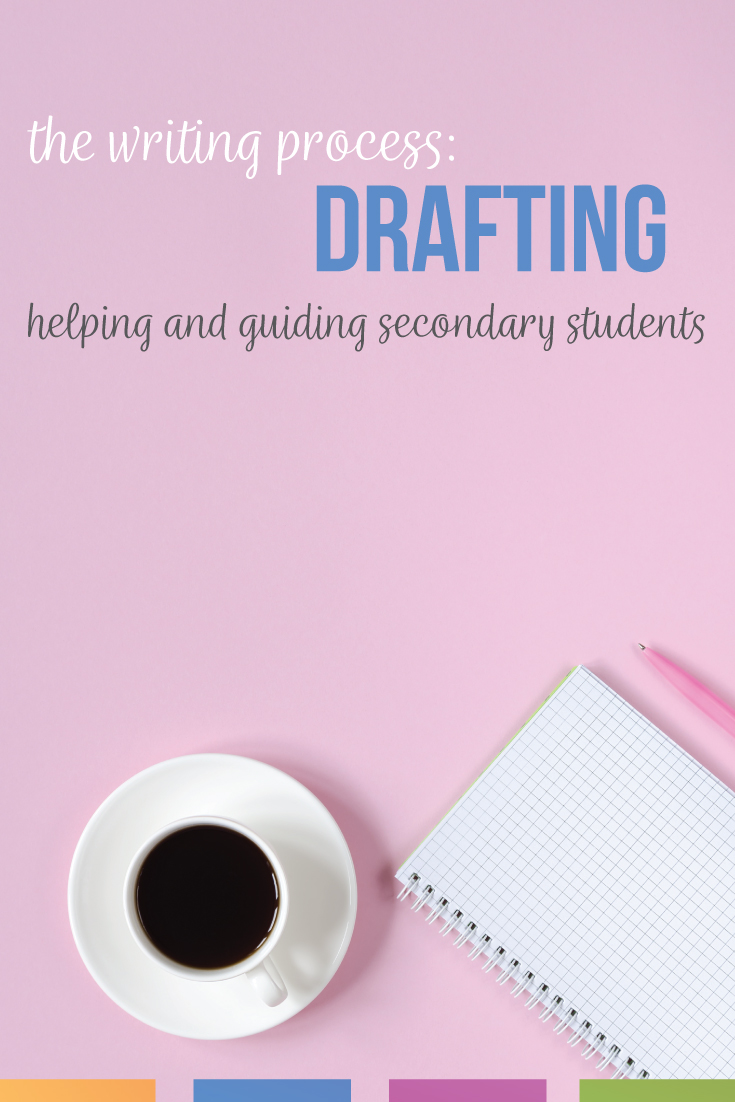
After successfully drafting an essay with a high school class, we are ready to move to revising essays. The next post in my writing process series continues to cover how I treat writing as a recursive activity.
We never stop reading and working on our papers. During the drafting stage, we return to our prewriting. The writing process is recursive, and students should practice piecing their ideas together, the larger goal of writing a paper. Drafting looks different in every classroom, I’m sure. It looks different for my students every year, from day to day. In this post, I aimed to provide an overview of how I guide my students. I’m sure you’ll make these ideas work for your community of learners.
Like these ideas? My writing bundle for secondary students incorporate many of the ideas I shared in this post.
Are you looking for the next post in the writing process? Revising is next.


